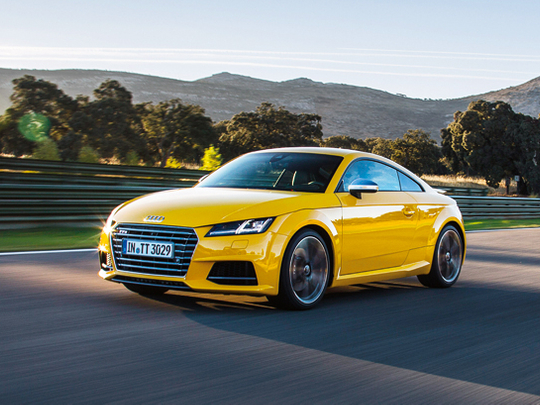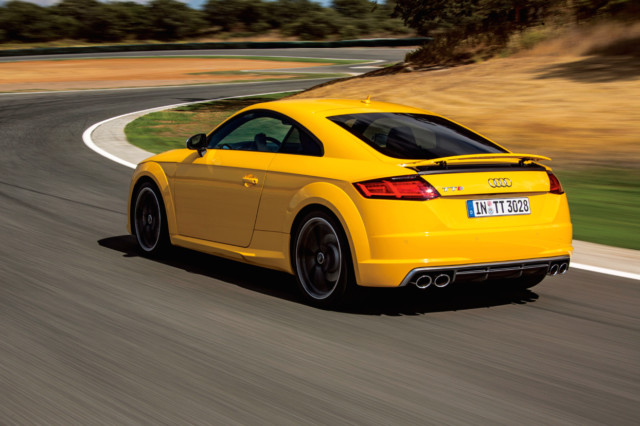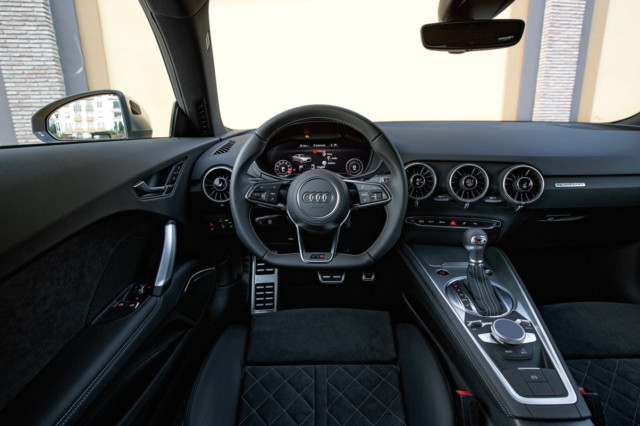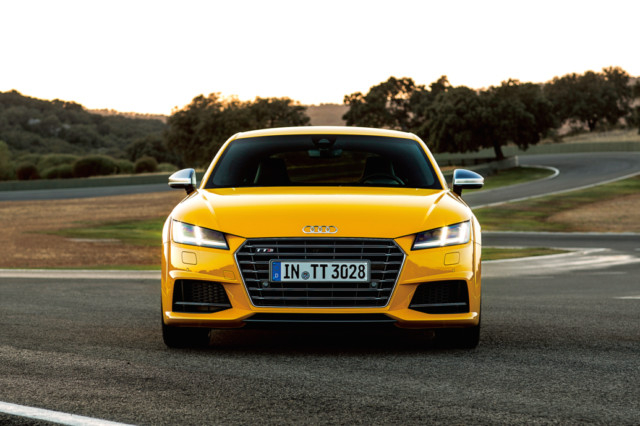
I know what you’re thinking — the new Audi TT looks a bit boring. And you would have a point, considering the 1998 original was a resplendent triumph of style. Notwithstanding the fact that underneath its svelte body lurked an Mk4 Golf (perhaps the worst of the breed), the Peter Schreyer-designed coupé was remarkable success. With the second-generation car, Audi dialed back on the edgy design and focused on the dynamics instead. The Mk3 TT is a step forward in the same direction.
Based on VW Group’s scalable MQB platform, the new car is dimensionally almost identical to the outgoing version, however the wheelbase has been extended by 37mm for increased room in the cabin. For perspective, the TT is still shorter than the related A3 (by 131mm) and the Golf (by 132mm), which makes it vastly more chuckable.
Another upshot of this backbone-sharing is the hotter TTS weighs just under 1,400kg (which isn’t bad for a car with all-wheel drive) and is up to 25 per cent stiffer than before. As a result it goes harder, stops better and changes direction with greater urgency than before. All good news.
Power is still courtesy of the familiar VW Group 2.0 TFSI engine, which in our European-spec TTS serves up 306bhp, and 380Nm of torque from as low as 1,800rpm. The engine has been beefed up with sturdier innards, while the turbo now spools up to a 1.2 bar, compressing up to 1,000kg of air per hour. In simple terms: this thing is properly quick in a straight line. Zero to 100kph split is smashed in 4.6 seconds, which is incidentally the same as the original R8 4.2, and the top speed is limited to 250kph. But spec-sheet chatter is one thing; how do these figures translate in the real world?
The TTS that I’m driving along the glorious mountain roads near Rhonda feels quietly self-assured. There’s grip, lots of it, and the quattro all-wheel-drive system can flit 100 per cent of the power to the rear rubbers should the need arise. Understeer is not as chronic as previous versions, but this is no tail-wagging miniature R8 either. It’s all very pleasant and manageable.
Most recent Audis — even the really fast ones like the RS7, and with the sole exception of the R8 — are saddled with a muddy steering that saps the fun out of proceedings. The TTS, however, does a fairly decent job. It’s a touch too soft for my liking and doesn’t always authoritatively convey what the front wheels are up to, but it is a definite improvement over its predecessor.
In Dynamic mode, which is the only way to drive the TT in my opinion, the whole car tightens up. The suspension gets stiffer (although not unpleasantly so), the steering is rendered heavier, the double-clutch six-speed auto holds gears for longer and the mechanical burble of the engine is garnished with some tasty pops and crackles on the overrun. It’s all very nice, but somehow it just isn’t exciting enough. More on that later.
Audi representatives at the launch spoke at considerable length about the look of the new aircraft-inspired dashboard and air vents as well as the customisable hi-res 1,440-pixel digital display that apparently affords the feeling of being in a cockpit (the TT is the only car in its class with fully digital instruments) and the cabin does look good. But the pachyderm in the room is the exterior styling, which feels a bit safe. Bland even. Save the aggressive front end with the optional LED matrix headlights, there isn’t a great deal to write home about.
As a driving machine though, there isn’t much to fault about the new TT either. It’s not a car that will send you hunting for roundabouts and off-ramps on the way home like a Porsche Boxster or a Cayman would, but it gets the job done with a stony-face effectiveness that you’d expect from something like a Volkswagen Golf R (see page 32).
In fact, that could well be the best way to sum up the new Audi TTS. Despite all its merits, and some foibles, it essentially feels like a better-looking version of VW’s hot hatch — which makes the same amount of power as our detuned 286bhp Middle East TTs.
Granted, the Ingolstadt car will crane more necks (especially in the shouty yellow paint) and outrun the Vee Dub in a straight line, but give them a twisty mountain road and the Audi will struggle to shake off its four-door, four-seat sister from Wolfsburg. know what you’re thinking — the new Audi TT looks a bit boring. And you would have a point, considering the 1998 original was a resplendent triumph of style. Notwithstanding the fact that underneath its svelte body lurked an Mk4 Golf (perhaps the worst of the breed), the Peter Schreyer-designed coupé was remarkable success. With the second-generation car, Audi dialed back on the edgy design and focused on the dynamics instead. The Mk3 TT is a step forward in the same direction.
Based on VW Group’s scalable MQB platform, the new car is dimensionally almost identical to the outgoing version, however the wheelbase has been extended by 37mm for increased room in the cabin. For perspective, the TT is still shorter than the related A3 (by 131mm) and the Golf (by 132mm), which makes it vastly more chuckable.
Another upshot of this backbone-sharing is the hotter TTS weighs just under 1,400kg (which isn’t bad for a car with all-wheel drive) and is up to 25 per cent stiffer than before. As a result it goes harder, stops better and changes direction with greater urgency than before. All good news.
Power is still courtesy of the familiar VW Group 2.0 TFSI engine, which in our European-spec TTS serves up 306bhp, and 380Nm of torque from as low as 1,800rpm. The engine has been beefed up with sturdier innards, while the turbo now spools up to a 1.2 bar, compressing up to 1,000kg of air per hour. In simple terms: this thing is properly quick in a straight line. Zero to 100kph split is smashed in 4.6 seconds, which is incidentally the same as the original R8 4.2, and the top speed is limited to 250kph. But spec-sheet chatter is one thing; how do these figures translate in the real world?
The TTS that I’m driving along the glorious mountain roads near Rhonda feels quietly self-assured. There’s grip, lots of it, and the quattro all-wheel-drive system can flit 100 per cent of the power to the rear rubbers should the need arise. Understeer is not as chronic as previous versions, but this is no tail-wagging miniature R8 either. It’s all very pleasant and manageable.
Most recent Audis — even the really fast ones like the RS7, and with the sole exception of the R8 — are saddled with a muddy steering that saps the fun out of proceedings. The TTS, however, does a fairly decent job. It’s a touch too soft for my liking and doesn’t always authoritatively convey what the front wheels are up to, but it is a definite improvement over its predecessor.
In Dynamic mode, which is the only way to drive the TT in my opinion, the whole car tightens up. The suspension gets stiffer (although not unpleasantly so), the steering is rendered heavier, the double-clutch six-speed auto holds gears for longer and the mechanical burble of the engine is garnished with some tasty pops and crackles on the overrun. It’s all very nice, but somehow it just isn’t exciting enough. More on that later.
Audi representatives at the launch spoke at considerable length about the look of the new aircraft-inspired dashboard and air vents as well as the customisable hi-res 1,440-pixel digital display that apparently affords the feeling of being in a cockpit (the TT is the only car in its class with fully digital instruments) and the cabin does look good. But the pachyderm in the room is the exterior styling, which feels a bit safe. Bland even. Save the aggressive front end with the optional LED matrix headlights, there isn’t a great deal to write home about.
As a driving machine though, there isn’t much to fault about the new TT either. It’s not a car that will send you hunting for roundabouts and off-ramps on the way home like a Porsche Boxster or a Cayman would, but it gets the job done with a stony-face effectiveness that you’d expect from something like a Volkswagen Golf R (see page 32).
In fact, that could well be the best way to sum up the new Audi TTS. Despite all its merits, and some foibles, it essentially feels like a better-looking version of VW’s hot hatch — which makes the same amount of power as our detuned 286bhp Middle East TTs.
Granted, the Ingolstadt car will crane more necks (especially in the shouty yellow paint) and outrun the Vee Dub in a straight line, but give them a twisty mountain road and the Audi will struggle to shake off its four-door, four-seat sister from Wolfsburg.
















